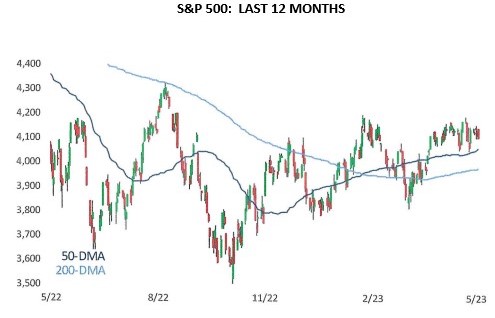Stocks remain in no man’s land, with neither side making much progress. This probably helps to explain why the market doesn’t feel much like a bull or bear. From a technical perspective, we are still in a bear market but remain in a tight trading range. The S&P 500 is essentially right around the same levels it was at 12 months ago, nine months ago, six months ago, or three months ago. The following graph shows the S&P 500 index level over the last 12 months. Notice the tight trading range:

Source: Bespoke Investment Group
Without confirmation from the market, bulls have been bombarded with negative headlines concerning the debt ceiling and slower economic data. If that is not bad enough, add tight credit conditions from the ongoing stress in the banking system. Cyclical commodities have been rolling over, pointing to more economic weakness ahead. And semiconductor stocks, a leading indicator for the market, haven’t been faring well.
Bears shouldn’t get complacent, though. The Q1 earnings season has been anything but weak. More companies have been raising guidance than lowering guidance. Tech stocks just recently hit a 52-week high. Weaker commodity prices are feeding lower inflation. If you are a bear, you should be aware that it is standing room only in the den, with sentiment skewed firmly in bearish territory.
The market can’t make up its mind right now. When there is resolution on the debt ceiling and the Fed takes its foot off the gas, maybe we will get some traction to the upside, but for now, we remain stuck in mud.
As we just mentioned, we remain in a bear market. However, there are green shoots giving some investors hope that this cycle rhymes with previous bear market lows. One such green shoot: The Fed’s interest rate hiking cycle may be nearing its end amid signs of receding inflation. Broad-based market rallies followed the conclusions of the past four tightening cycles. Here are the average stock returns 12 months after the past four hiking cycles ended:
By region:
S. Equity +20%
Global Equity +16%
Emerging Market’s Equity 14%
By size (U.S.):
large caps +20%
mid caps +23
small caps +19%
Source: Morningstar and Standard and Poors
This historical precedent gives us hope, too, but with a looming recession, it is hard for us to accept that stocks will break to the upside from here, especially at current valuations. We wrote in our last commentary that stocks have never bottomed in a bear market before a recession has started and we expect this to hold true this time around. Those investors who believe we will have a soft landing are getting more bullish. The rest of us expect further choppiness ahead.
ARE MY ASSETS SAFE AT SCHWAB?
We have received a few inquiries from clients with questions about the safety of their money at Schwab. Schwab has been in the news because the banking side of their business made investments in high-quality, long-term bonds whose prices have declined as interest rates have risen. Here is why we are not concerned about the safety of your assets (or ours) at Schwab:
First, if there is an institution “too big to fail,” it is Schwab with over $7.6 trillion in customer custodian assets. This is over three times as large as our nation’s largest bank, JP Morgan Chase, with $2.3 trillion in customer deposits. Any Schwab customer losing money would be like dropping a bomb on our economy. Customers losing money on their cash at Schwab would create a run on the bank like we have never seen before. This alone would cause the government to bail out Schwab’s customers, in our view. It is important to note that Schwab’s issues are much less severe than those of the banks that failed.
Second, and more objective, your stocks, bonds, and money market funds are registered in your name as database entries and cannot, by law, be commingled with Schwab’s corporate assets. Your securities cannot be taken away from you even if Schwab was to go bankrupt.
Cash (not invested in a money market fund) has three layers of insurance: FDIC insurance up to $500,000 per account registration, SIPC cash insurance of $250,000, and Schwab’s own insurance that covers (uninvested) cash up to $1.15 million per customer.
We keep uninvested cash to an absolute minimum. Dividends and interest received are promptly swept into a money market fund. The only time we raise cash from the money market fund is for client disbursements, trade settlements, or management fees.
